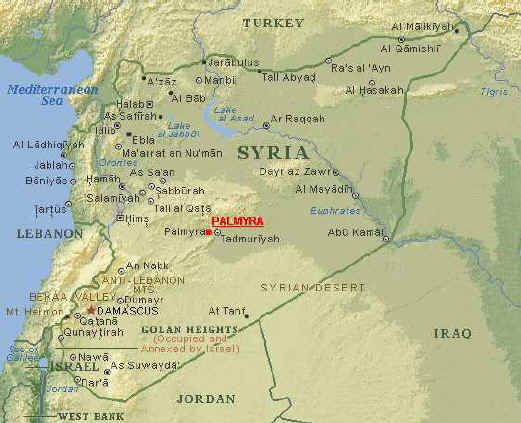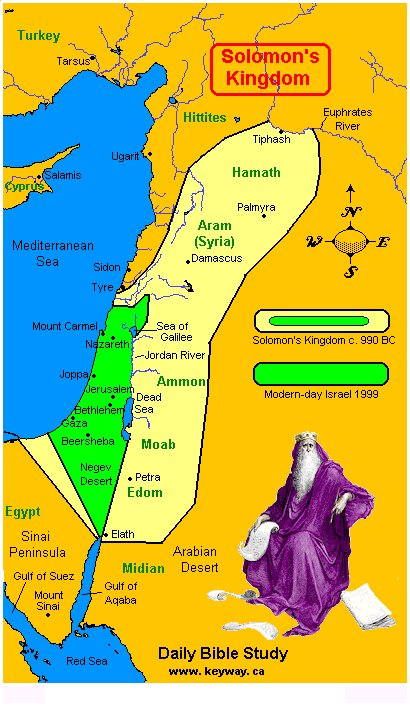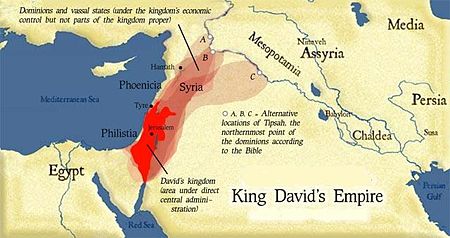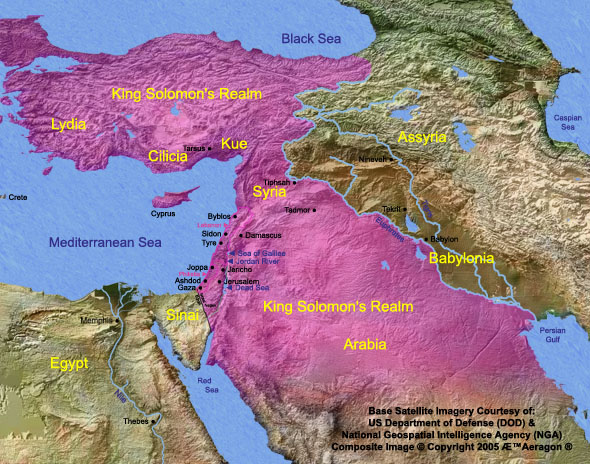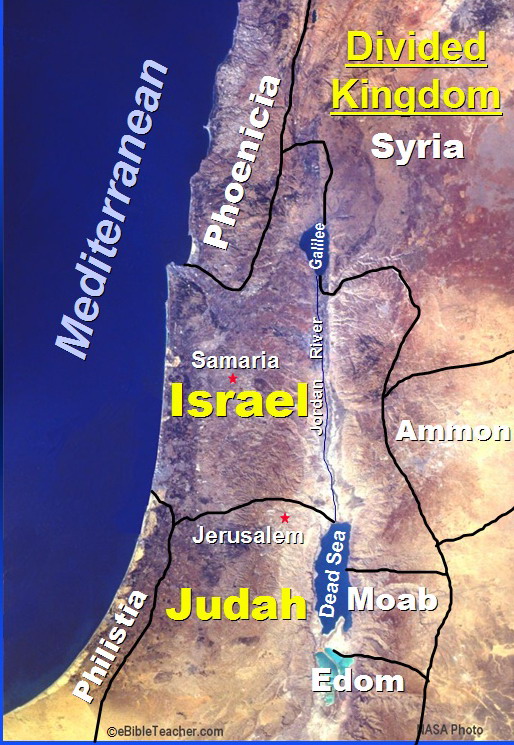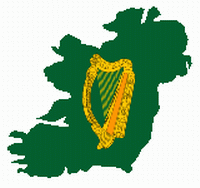The First Book of Kings
The First Book of Kings
Chapter Nine
Mini-Article and Notes of Interest
Selection of Maps.
Where was Ophir?
1-Kings 9
[1-Kings 9:1] AND IT CAME TO PASS, WHEN
SOLOMON HAD FINISHED THE BUILDING OF THE HOUSE OF THE LORD, AND THE KING'S
HOUSE, AND ALL SOLOMON'S DESIRE WHICH HE WAS PLEASED TO DO,
Everything Solomon conceived to do he made plans about it and carried
them out.
[1-Kings 9:2] THAT THE LORD APPEARED TO
SOLOMON THE SECOND TIME, AS HE HAD APPEARED UNTO HIM AT
GIBEON.
In Gibeon (also pronounced "Givon") the Almighty had appeared to Solomon
(1-Kings 3:5). Gibeon was the location of a major high place (Hebrew: "Bama")
where Solomon offered up a 1000 sacrifices. God appeared to him in a dream at
night and asked him what he wanted (1-Kings 3:6). Solomon asked for AN
UNDERSTANDING HEART TO JUDGE THY PEOPLE, THAT I MAY DISCERN BETWEEN GOOD AND BAD
(1-Kings 3:6). God agreed to his request and added that HE would also give him
more riches and honor than any other monarch in his time (1-Kings 3:13).
[1-Kings 9:3] AND THE LORD SAID UNTO
HIM, I HAVE HEARD THY PRAYER AND THY SUPPLICATION, THAT THOU HAST MADE BEFORE
ME: I HAVE HALLOWED THIS HOUSE, WHICH THOU HAST BUILT, TO PUT MY NAME THERE FOR
EVER; AND MINE EYES AND MINE HEART SHALL BE THERE PERPETUALLY.
The Presence of God is always on the Temple Mount. It is also on the
Western Wall which is a remnant of the Temple. The Almighty may be acessed from
anywhere but some places are more amenable than others.
[1-Kings 9:4] AND IF THOU WILT WALK
BEFORE ME, AS DAVID THY FATHER WALKED, IN INTEGRITY OF HEART, AND IN
UPRIGHTNESS, TO DO ACCORDING TO ALL THAT I HAVE COMMANDED THEE, AND WILT KEEP MY
STATUTES AND MY JUDGMENTS:
[1-Kings 9:5] THEN I WILL ESTABLISH THE
THRONE OF THY KINGDOM UPON ISRAEL FOR EVER, AS I PROMISED TO DAVID THY FATHER,
SAYING, THERE SHALL NOT FAIL THEE A MAN UPON THE THRONE OF ISRAEL.
Here he is promised that his offspring would always rule over Israel as
long as he or they go in the right way, as explained below.
[1-Kings 9:6] BUT IF YE SHALL AT ALL
TURN FROM FOLLOWING ME, YE OR YOUR CHILDREN, AND WILL NOT KEEP MY COMMANDMENTS
AND MY STATUTES WHICH I HAVE SET BEFORE YOU, BUT GO AND SERVE OTHER GODS, AND
WORSHIP THEM:
[1-Kings 9:7] THEN WILL I CUT OFF ISRAEL
OUT OF THE LAND WHICH I HAVE GIVEN THEM; AND THIS HOUSE, WHICH I HAVE HALLOWED
FOR MY NAME, WILL I CAST OUT OF MY SIGHT; AND ISRAEL SHALL BE A PROVERB AND A
BYWORD AMONG ALL PEOPLE:
[1-Kings 9:8] AND AT THIS HOUSE, WHICH
IS HIGH, EVERY ONE THAT PASSETH
BY IT SHALL BE ASTONISHED, AND SHALL HISS; AND THEY SHALL SAY, WHY HATH THE LORD
DONE THUS UNTO THIS LAND, AND TO THIS HOUSE?
Here the destruction of the Temple is predicted.
The Temple is still destroyed.
Not only that but Moslem Arabs rule over it, dig it up, build mosques on it,
etc. They have a public school on the Temple Mount and visitors can watch the
boys play soccer. They also have public toilets on it and crazy infantile pagan
islamic lunatics running about it. Jews are not allowed to pray there. Under
special conditions Jewish visitors are sometimes allowed to go up to the Temple
Mount. They will be accompanied by an Israeli policeman and at least one brawny
semi-literate Moslem religious official who is liable to throw a fit if the Jew
just looks like praying.
As long as the Temple remains in ruins all of Israel is in
shame.
[1-Kings 9:9] AND THEY SHALL ANSWER,
BECAUSE THEY FORSOOK THE LORD THEIR GOD, WHO BROUGHT FORTH THEIR FATHERS OUT OF
THE LAND OF EGYPT, AND HAVE TAKEN HOLD UPON OTHER GODS, AND HAVE WORSHIPPED
THEM, AND SERVED THEM: THEREFORE HATH THE LORD BROUGHT UPON THEM ALL THIS EVIL.
The Jews never abandoned the One True God but maybe we never got back to HIM as
we should have?
[1-Kings 9:10] AND IT CAME TO PASS AT
THE END OF TWENTY YEARS, WHEN SOLOMON HAD BUILT THE TWO HOUSES, THE HOUSE OF THE
LORD, AND THE KING'S HOUSE,
[1-Kings 9:11] (NOW HIRAM THE KING OF
TYRE
HAD FURNISHED SOLOMON WITH CEDAR TREES AND FIR TREES, AND WITH GOLD, ACCORDING
TO ALL HIS DESIRE,) THAT THEN KING SOLOMON GAVE HIRAM TWENTY CITIES IN THE LAND
OF GALILEE.
Hiram was the King of Tyre which was the chief city of Phoenicia. The
Phoenicians were foremost navigators of the ancient world and had established
bases ion the BRITISH Isles and in Spain and on the Werst Coast (according to
Tacitus) of Europe.
[1-Kings 9:12] AND HIRAM CAME OUT FROM
TYRE
TO SEE THE CITIES WHICH SOLOMON HAD GIVEN HIM; AND THEY PLEASED HIM
NOT.
[1-Kings 9:13] AND HE SAID, WHAT CITIES
ARE THESE WHICH THOU HAST GIVEN ME, MY BROTHER? AND HE CALLED THEM THE LAND OF
CABUL
UNTO THIS DAY.
Hiram was not pleased with the cities. Nevertheless, it is not clear from the
above whether or not Hiram accepted them. From 2-Chronicles 8:1-2 however it
seems that Hiram returned the cities to Solomon who then settled them with
Israelites.
It seems surprising that Solomon would even tentatively offer any part of
Israelite Territory to a foreign potentate.
From the parallel passage in Chronicles we see that at that time they were not
inhabited by Israelites.
Only after Hiram had rejected them did Israelites settle in them.
AND IT CAME TO PASS AT THE END OF TWENTY
YEARS, WHEREIN SOLOMON HAD BUILT THE HOUSE OF THE LORD, AND HIS OWN HOUSE,
[2-Chronicles 8:1]
THAT THE CITIES WHICH HURAM
HAD RESTORED TO SOLOMON, SOLOMON BUILT THEM, AND CAUSED THE CHILDREN OF ISRAEL
TO DWELL THERE [2-Chronicles 8:2].
The twenty cities in THE LAND OF CABUL are described as being IN THE LAND OF
GALILEE.
Yehudah Kiel (Daat Mikra) gives an explanation which though convincing would
require us to extend our concept as to what is meant by "Galilee" to somewhere
much further north than is commonly assumed. Kiel quotes from Josephus
(Antiquities 8:142) that the cities were in the north bordering Tyre. They were
in the territory of the Israelite Tribe of Asher most of whose inhabitants were
non-Israeli Canaanites (Judges 1:32). According to the Radak there was an
exchange of territory with Hiram giving Solomon twenty cities and Solomon
offering Hiram in exchange another twenty cities whose inhabitants were Gentiles
but Israel ruled over.
Other explanations exist such as that Solomon was not actually offering Hiram
control of the cities but rather the revenue accruing from
them.
[1-Kings 9:14] AND HIRAM SENT TO THE
KING SIXSCORE
TALENTS OF GOLD.
SIXSCORE i.e. six times 20 meaning 120.
TALENTS. In Hebrew "Kikar" which Daat Mikra says is about 30 kilogram, i.e.
Hiram sent to Solomon 3600 kilogram of gold. This is not a fantastic quantity
by modern standards. South Africa produces ca. 230,000 kilograms of gold each
year.
The Phoenicians were present in East Africa and possibly South Africa as well
where gold was available.
A large quantity of gold products from the Bronze Ages has been found in
Ireland. These are so plentiful that archaeologists believe that the gold must
have been mined in Ireland itself but exactly where they are still unable to
say!
[1-Kings 9:15] AND THIS IS THE REASON OF
THE LEVY WHICH KING SOLOMON RAISED; FOR TO BUILD THE HOUSE OF THE LORD, AND HIS
OWN HOUSE, AND MILLO,
AND THE WALL OF JERUSALEM, AND
HAZOR, AND MEGIDDO, AND
GEZER.
MILLO is not necessarily the name of a place. In Hebrew "milo" means
"filling". It is thought that Solomon encompassed an area adjoining the City of
David (Jerusalem) and filled it up with stones and dirt to build upon
it.
[1-Kings 9:16] FOR PHARAOH KING OF EGYPT
HAD GONE UP, AND TAKEN GEZER,
AND BURNT IT WITH FIRE, AND SLAIN THE CANAANITES THAT DWELT IN THE CITY, AND
GIVEN IT FOR A PRESENT UNTO HIS DAUGHTER, SOLOMON'S WIFE.
GEZER was in the territory of Ephraim north of Jerusalem. It had been
inhabited by Canaanites whom the Ephraimites subjected in the time of Joshua
(Joshua 17:10). What exactly Pharaoh was doing in that region is not clear.
Perhaps the Canaanite inhabitants of Gezer had rebelled and gone to war against
Israel? Solomon would then have employed Pharaoh to deal with the problem? It
could be that previous to their rebellion the people of Gezer had had some kind
of sacred covenant with Israel. By going to war they would have broken the
covenant but Solomon may still not have been able to take extreme measures
against them because of it. Solomon therefore used Pharaoh of Egypt to deal with
the matter.
A similar situation may exist today in Israel.
International pressures, Arab intransigence, a left-wing media and Establishment
all combined to force Israel to undertake sundry obligations and agreements with
the Palestinians.
The Palestinians then immediately began to blatantly break all the terms they
had agreed to but had never intended to keep anyway.
Israel would be in its right to disregard all agreements that have been made
since the other side never ever kept its part of the bargain.
Nevertheless Israel is only able to react to Palestinians provocations to a
limited degree since the powers that be will not let her do more and they
consider Israel to still be bound by its "obligations".
Solomon would not have been so constrained since Israel at that time was
probably the most powerful nation in the world. Nevertheless there is a Biblical
principle that one must not only be in the right but also look the part.
This may be why in the future both Judah and Ephraim will have to co-operate
together to fly the Palestinians away to some place in the west.
[Isaiah 11:12] HE WILL RAISE AN ENSIGN
FOR THE NATIONS, AND WILL ASSEMBLE THE OUTCASTS OF ISRAEL [The Lost Ten Tribes],
AND GATHER THE DISPERSED OF JUDAH [the Jews] FROM THE FOUR CORNERS OF THE
EARTH.
[Isaiah 11:13] THE JEALOUSY OF EPHRAIM SHALL DEPART, AND THOSE WHO HARASS JUDAH
SHALL BE CUT OFF; EPHRAIM SHALL NOT BE JEALOUS OF JUDAH, AND JUDAH SHALL NOT
HARASS EPHRAIM.
[Isaiah 11:14] THEY SHALL FLY THE PHILISTINES AWAY WESTWARD...
See:
http://www.britam.org/isaiah/Isaiah11to15.html#11
http://www.britam.org/hamas.html
[1-Kings 9:17] AND SOLOMON BUILT
GEZER,
AND BETHHORON
THE NETHER,
By "built" it is understood that he made them fortress cities. These
cities were on the border area between Ephraim and Benjamin.
GEZER. Pharoah conquered the city and burnt it giving the site to Solomon as a
dowry when Solomon marrried his daughter.
For the importance of the marriage of the daughter of Solomon
See above our mini-article on the subject in the Brit-Am Commentary to 1-Kings 3:1.
Like wise, see also our notes on "Gezer" also following the Brit-Am Commentary above to 1-Kings 3:1.
BETHHORON THE NETHER i.e. Lower Beth-Horon to distinguish it from the adjacent
Upper Bet-Horon.
[1-Kings 9:18] AND
BAALATH,
AND TADMOR
IN THE WILDERNESS, IN THE LAND,
BAALATH is a place possibly in Lebanon.
Tadmor is identified with Palmyria 250 kilometers northeast of modern Damascus
at the entranceway to Mesopotamia and the Arabian Desert.
[1-Kings 9:19] AND ALL THE CITIES OF
STORE THAT SOLOMON HAD, AND CITIES FOR HIS CHARIOTS, AND CITIES FOR HIS
HORSEMEN, AND THAT WHICH SOLOMON DESIRED TO BUILD IN JERUSALEM, AND IN LEBANON,
AND IN ALL THE LAND OF HIS DOMINION.
Excavations at Megiddo in the northern Galilee revealed a large number of
stables built out of stone. These were considered to have been built by
Solomon.
Selection of Maps
[1-Kings 9:20] AND ALL THE PEOPLE THAT
WERE LEFT OF THE AMORITES, HITTITES,
PERIZZITES,
HIVITES,
AND JEBUSITES,
WHICH WERE NOT OF THE CHILDREN OF ISRAEL,
[1-Kings 9:21] THEIR CHILDREN THAT WERE
LEFT AFTER THEM IN THE LAND, WHOM THE CHILDREN OF ISRAEL ALSO WERE NOT ABLE
UTTERLY TO DESTROY, UPON THOSE DID SOLOMON LEVY A TRIBUTE OF
BONDSERVICE
UNTO THIS DAY.
Subject peoples who were not destroyed or expelled but agreed to accept the
authority of the God of Israel (without converting) and the People of Israel
were to work for the Israelites:
[Deuteronomy 20:10] WHEN THOU
COMEST
NIGH UNTO A CITY TO FIGHT AGAINST IT, THEN PROCLAIM PEACE UNTO IT.
[Deuteronomy 20:11] AND IT SHALL BE, IF
IT MAKE THEE ANSWER OF PEACE, AND OPEN UNTO THEE, THEN IT SHALL BE, THAT ALL
THE PEOPLE THAT IS FOUND THEREIN SHALL BE TRIBUTARIES UNTO THEE, AND THEY SHALL
SERVE THEE.
[1-Kings 9:22] BUT OF THE CHILDREN OF
ISRAEL DID SOLOMON MAKE NO BONDMEN: BUT THEY WERE MEN OF WAR, AND HIS SERVANTS,
AND HIS PRINCES, AND HIS CAPTAINS, AND RULERS OF HIS CHARIOTS, AND HIS
HORSEMEN.
[1-Kings 9:23] THESE WERE THE CHIEF OF
THE OFFICERS THAT WERE OVER SOLOMON'S WORK, FIVE HUNDRED AND FIFTY, WHICH BARE
RULE OVER THE PEOPLE THAT WROUGHT IN THE WORK.
[1-Kings 9:24] BUT PHARAOH'S DAUGHTER CAME UP OUT OF THE CITY OF DAVID UNTO HER
HOUSE WHICH SOLOMON HAD BUILT FOR HER: THEN DID HE BUILD
MILLO.
[1-Kings 9:25] AND THREE TIMES IN A YEAR
DID SOLOMON OFFER BURNT OFFERINGS AND PEACE OFFERINGS UPON THE ALTAR WHICH HE
BUILT UNTO THE LORD, AND HE BURNT INCENSE UPON THE ALTAR THAT WAS BEFORE THE
LORD. SO HE FINISHED THE HOUSE.
[1-Kings 9:26] AND KING SOLOMON MADE A NAVY OF SHIPS IN
EZIONGEBER,
WHICH IS BESIDE ELOTH,
ON THE SHORE OF THE RED SEA, IN THE LAND OF EDOM.
EZIONGEBER i.e. Etsion-Geber.
ELOTH present-day Elat.
[1-Kings 9:27] AND HIRAM SENT IN THE
NAVY HIS SERVANTS, SHIPMEN THAT HAD KNOWLEDGE OF THE SEA, WITH THE SERVANTS OF
SOLOMON.
Hiram was King of Tyre the major Phoenician city. They were participants
in the maritime enterprises of King Solomon.
For more on this matter see:
Brit-Am Answers to Queries on
Tarshish
http://www.britam.org/Questions/QuesTarshish.html
All of the entries in the above articvle are pertinent but read
espcially under the heading:
The Bible and
Tarshish
http://www.britam.org/Questions/QuesTarshish.html#Bible
[1-Kings 9:28] AND THEY
CAME TO OPHIR,
AND FETCHED FROM THENCE GOLD, FOUR HUNDRED AND TWENTY TALENTS, AND BROUGHT IT TO
KING SOLOMON.
Where was
Ophir?
|
The Bible says that Phoenician ships in association with
King Solomon sailed to Ophir to bring back gold. Where was Ophir? Opinions vary from South America, India, Indonesia,
Australia, to Africa. In the article below we briefly discuss some of the issues involved
and opt for somewhere in South Africa, possibly Mozambique.
|
Some say Ophir was Ancient Peru.
We now think it to have been somewhere in Africa.
In Hebrew "Ophir" is written with the same root-letters ("AFR") as the name for
"ashes" (AFeR) connoting black.
This is where the name "Africa" comes from.
We would identify "Ophir" with some place in Africa possibly South Africa.
A famous adventure story named "King Solomon's Mines" by H. Rider Haggard (1885)
is located somewhere in East Africa.
Further on in 1-Kings 10:11 Gold and almug trees from Ophir are mentioned in the
very middle of the story of the Queen of Sheba who came to visit Solomon.
[1-Kings 10:11] AND THE NAVY ALSO OF
HIRAM, THAT BROUGHT GOLD FROM
OPHIR, BROUGHT IN FROM
OPHIR
GREAT PLENTY OF ALMUG
TREES, AND PRECIOUS STONES.
Mozambique
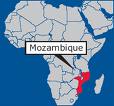 |
We will talk more about the Queen of Sheba when we get to chapter 10 but all the
indications are that she either came from Southern Arabia (possibly Yemen) with
dominion over neighboring Ethiopia or from somewhere in Africa. The mention of
Gold from Ophir would not have been interposed in the midst of the account
concerning the Queen of Sheba unless there was some connection to her. From Sheba she may have ruled over Ophir
or had close connections to it.
The identifification of Ophir with Mozambique has much to say for itself.
|
Also in 2-Chronicles the account of gold from Ophir follows immediately after
the note on the Queen of Sheba:
[2-Chronicles 8:18] AND
HURAM
SENT HIM BY THE HANDS OF HIS SERVANTS SHIPS, AND SERVANTS THAT HAD KNOWLEDGE OF
THE SEA; AND THEY WENT WITH THE SERVANTS OF SOLOMON TO
OPHIR,
AND TOOK THENCE FOUR HUNDRED AND FIFTY TALENTS OF GOLD, AND BROUGHT THEM TO KING
SOLOMON.
[2-Chronicles 9:1] AND WHEN THE QUEEN OF
SHEBA HEARD OF THE FAME OF SOLOMON, SHE CAME TO PROVE SOLOMON WITH HARD
QUESTIONS AT JERUSALEM, WITH A VERY GREAT COMPANY, AND CAMELS THAT BARE SPICES,
AND GOLD IN ABUNDANCE, AND PRECIOUS STONES: AND WHEN SHE WAS COME TO SOLOMON,
SHE COMMUNED WITH HIM OF ALL THAT WAS IN HER HEART.
We would suggest that Queen of Sheba became interested in King Solomon after an
encounter with Israelite and Phoenician emissaries in the service of Solomon.
Extracts from the Wikipedia article on Ophir:
Ophir [note the possibility mentioned below concerning
Australia]
http://en.wikipedia.org/wiki/Ophir
From Wikipedia, the free encyclopedia
Extracts Only:
Ophir
in Genesis 10 (the Table of Nations) is said to be the name of one of the sons
of Joktan.
Biblical references to the land of
Ophir
are also found in 1 Kings 9:28; 10:11; 22:49; 1 Chronicles 29:4; 2 Chronicles
8:18; Book of Job 22:24; 28:16; Psalms 45:9; Isaiah 13:12.
Location
Biblical scholars, archaeologists and
others have tried to determine the exact location of
Ophir.
For instance, Vasco da
Gama's
companion Tom opes
reasoned that Ophir
was the ancient name for Great Zimbabwe in Zimbabwe (which through oral history,
is said to be ruled by a queen suspected to be the biblical Sheba), the main
center of sub-African trade in gold. Although the identification of
Ophir
with Sofala
[in Mozambique, South Africa] was mentioned by Milton in Paradise Lost
(11:399-401), among many other works of literature and science, it has since
been discarded.
In the 19th century Max Mueller and
other scholars identified Ophir
with Abhira,
at the mouth of the Indus River in modern-day Pakistan. Another possibility is
the African shore of the Red Sea, with the name perhaps being derived from the
Afar people of Ethiopia, Eritrea, and Djibouti. Most modern scholars still place
Ophir
either on the coast of either Pakistan or India, in what is now
Poovar,
or somewhere in southwest Arabia in the region of modern Yemen. This is also the
assumed location of Sheba. Saudi Arabia's cradle of gold, "Mahd
adh
Dhahab".
Easton's Bible Dictionary (1897) adds a
connection to "Sofir,"
the Coptic name for India. Josephus connected it with "Cophen,
an Indian river, and in part of Asia adjoining to it," (Antiquities of the Jews
I:6), sometimes associated with a part of Afghanistan.
En 1568, Alvaro
Menda
iscovered
the Solomon Islands, and named them as such because he believed them to be
Ophir.[1]
Proponents of pre-Columbian connections
between Eurasia and the Americas have suggested even more distant locations such
as modern-day Peru or Brazil. Author on topics in alternative history
David Hatcher Childress
goes so far as to suggest that
Ophir
was located in Australia; proposing that the cargoes of gold, silver and
precious stones were obtained from mines in the continent's north-west, and that
ivory, sandalwood and peacocks were obtained in South Asia on the voyage back to
Canaan.[2]
In the book entitled
Collecion
General de Documentos
Relativos
a las
Islas
Filipinas, the author has described how to locate
Ophir.
According to the book, particularly in
Documento
No. 98, Ophir
can be found by travelling
from the Cape of Good Hope in Africa, to India, to Burma, to Sumatra, to
Moluccas,
to Borneo, to Sulu,
to China, then finally Ophir.
Ophir
was said to be "[...] in front of China towards the sea, of many islands where
the Moluccans,
Chinese, and Lequios
met to trade..." This group of islands could not be Japan because the
Moluccans
did not get there. It could also not be Taiwan since it is not composed of "many
islands." Only the present-day Philippines could fit the description. Spanish
records also did mention of the presence of
Lequious
(big, bearded white men, probably descendants of the Phoenicians, whose ships
were always laden with gold and silver) in the Islands to gather gold and
silver.[3] Other evidences have also pointed out that the Philippines was indeed
the biblical Ophir.[4][5][6][7]
The article,
Locating Ophir - The Search for El Dorado
http://www.freechoudhury.com/Ophir.htm
Argues that Ophir was in Ceylon (Sri Lanka).
We however still opt for the African option.
1-Kings 10:11 says that not only gold was brought from Ophir but also "almug"
trees.
This has been identified with the red sandalwood or "red sanders wood" which is
native to southern India.
http://www.geocities.com/athens/parthenon/3664/almug.html
Algum trees however were also available from Lebanon (2-Chronicles
2:7). Alternately the algum trees had been brought to Lebanon from Ophir and a
large stockpile had accumulated which Hiram made available to Solomon?
We would tend to identify the almug tree with thyine wood
http://www.odu.edu/~lmusselm/plant/bible/thyinewoodnew.php
This tree is now
found in Northwest Africa but perhaps it was once present along the east coast
and in the south?
The thyine tree fits the description of the almug: it has an aromatic scent and
is suitable for making instruments and balustrades. It is also related to the
cypress so it may also have once been grown in Lebanon (2-Chronicles 2:7)
alongside the native Cypress trees there.
THUYA
BURL
http://www.creativepenworks.com/page8.html
In Morocco near Essaouira,
thuya
wood (and roots) are much-used for wood-work. It has been used since the days of
Solomon and David when it was called
thyine
wood. The Greeks named it thuya,
meaning sacrifice, because they used an oil distilled from it as incense in
their religious ceremonies. The wood is as beautiful as it is fragrant and the
Greeks and Romans vied with each other over furniture made from
thuya.
In those days, Thuya
Burl wood was traded "straight across", weight for weight with gold. Today
Moroccan artisans use the beautiful burled root wood to create distinctive
handcrafted items.
Sofala
- Mozambique
http://en.wikipedia.org/wiki/Sofala
Extracts:
The site of the oldest
harbour
documented in Southern Africa, medieval
Sofala
took its name from the Sofala
River which enters the Indian Ocean nearby. Vasco
da
Gama's
companion Thom?Lopes
left a narrative which identifies
Sofala
with the Biblical Ophir
and its ancient rulers with the dynasty of the queen of Sheba.
Sofala
thrived from about the year 700 AD. The Arabs had frequented the coast since
915, followed by traders from Persia. They conquered
Sofala
in the 1100s and strengthened its trading capacity by having, among other
things, river-going dhows ply the
Sofala
and Sabe
to ferry the gold extracted in the hinterland (mainly Zimbabwe) to the coast. In
the 14th and 15th centuries
Sofira was controlled by the
Sultan of Kilwa,
whose capital was in present-day Tanzania.
A Portuguese Jew, Pero
da
Covilha,
was the first European known to have visited
Sofala,
in the hope of discovering goldmines, in 1489. The Portuguese conquest of the
town followed in 1505, when Pero
de Anaia
assumed the title of Captain-General of
Sofala
and made it the first Portuguese colony in the region.
Sofala
lost its commercial preeminence once
Beira
was established 20 miles to the north in 1890. The
harbour
was once reputed to be capable of holding a hundred vessels, but has silted up
due to deforestation of the banks of the river and deposition of topsoil in the
harbour.
The Copper Mines of King Solomon.
King Solomon also mined copper in the area of Israel.
See:
Archeologists 'find King Solomon's mines'
http://www.news.com.au/heraldsun/story/0,21985,24567381-663,00.html
Extract:
IN a discovery straight out of an
Indiana Jones movie, archeologists believe they have uncovered one of the lost
mines of King Solomon.
The vast copper mine lies in an arid valley in modern-day Jordan and was created
in the 10th century BC - around the time Solomon is believed to have ruled over
the ancient Hebrews.
The mines are enormous and would have generated a huge income for the king, who
is famed for bringing extraordinary wealth and stability to the newly united
kingdom of Israel and Judah.
The announcement will reopen the debate about how much of the Old Testament is
myth and how much is history.
According to the Bible, Solomon was the third king of Israel.
The son of King David, he was renowned for his wisdom, the size of his harem and
the splendour
of his kingdom.
During his reign, he is said to have accumulated a huge fortune from mining and
trading, some of which was spent on building the grand temple and opulent palace
of Jerusalem.
